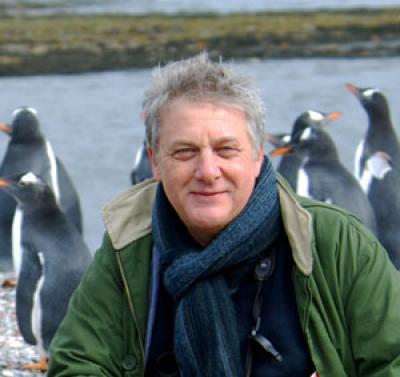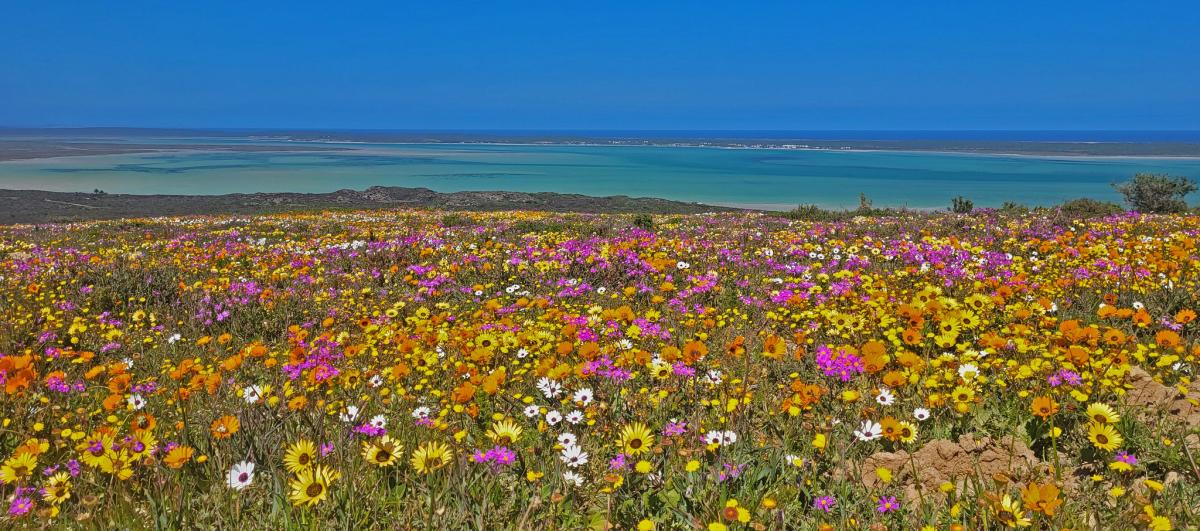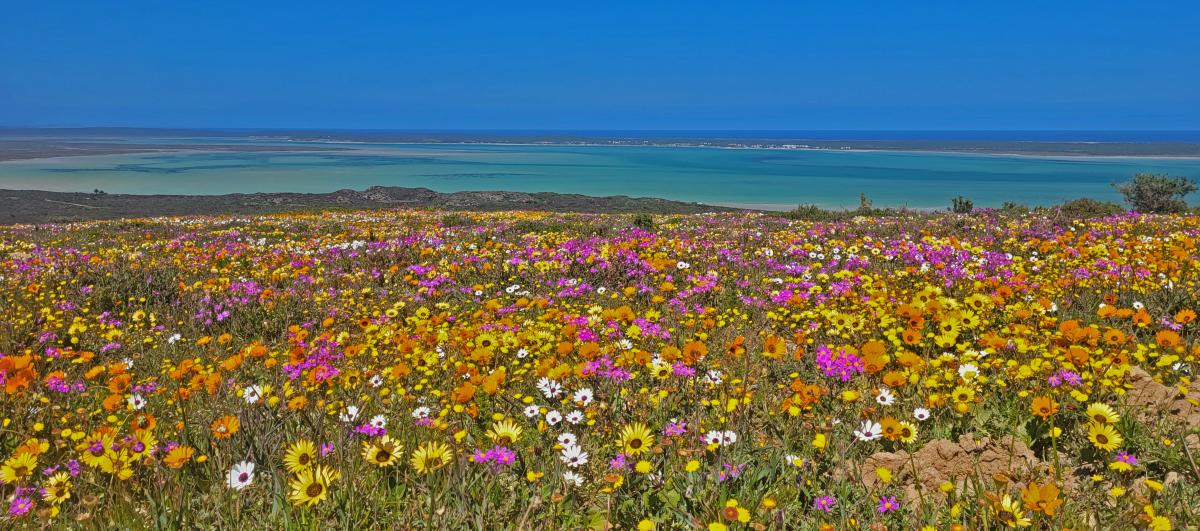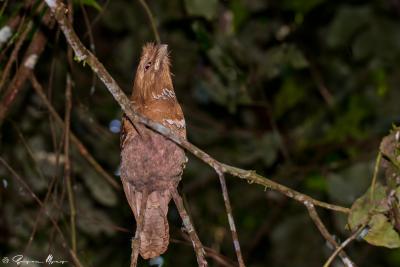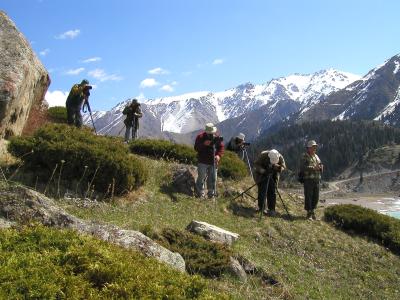South Africa: The West
Kalahari to the Cape
-
Aug 25 to Sep 10 2026
Steve Rooke
2026
Single Room Supplement $500
2026
Single Room Supplement $500
South Africa is a popular destination for birdwatchers, and a glance at one of its many excellent field guides soon reveals why. Over 700 different bird species occur here, of which over 100 are endemic or near-endemic. Thousands of kilometers of shoreline harbor migrant and resident birds, and some of the largest concentrations of seabirds in the world congregate offshore. In addition there is a wonderful infrastructure with great roads, comfortable accommodation, and superb food.
Late August into early September is the absolute best time to visit western South Africa. Spring will be under way, and many of the birds will be in full breeding plumage as they busy themselves with the onset of nesting. If the early rains have been good, they will have coaxed life from the desert and we should be treated to some wonderful wildflower displays. Our journey will take us from the rolling red sand dunes of the Kalahari Desert through the hauntingly beautiful plains of Bushmanland to the Atlantic coast. From there we’ll travel to the vast expanse of the Great Karoo before ending our tour where Africa itself ends and two oceans meet, at the windswept Cape of Good Hope. We have been running tours to South Africa for around 30 years and this itinerary has been designed to reflect the best birding the Western Cape has to offer at the very best time to visit the region.
This tour perfectly complements our South Africa: The East- Birds and Mammals tour for complete coverage of South Africa.
Day 1: The tour begins this evening in Johannesburg.
Day 2: We’ll take an early morning flight to Upington, collected our vehicle, and begin our drive north toward the Kalahari. We won't get far before we see the first of many massive Sociable Weaver nests perched atop roadside poles. Other species that could interrupt our journey include White-backed Vulture, Southern Pale Chanting Goshawk, Pygmy Falcon, Southern Ant-eating Chat, Fawn-colored Lark, and possibly Short-toed Rock Thrush. Night near Kgalagadi Reserve.
Day 3: Sandwiched between Namibia and Botswana, the Kgalagadi Trans Frontier Reserve is one of Africa’s wildest and least-known national parks. We’ll be at the reserve gate when it opens, and once inside we’ll head for a small waterhole where we should be treated to flocks of Namaqua Sandgrouse coming to drink, hopefully joined by good numbers of Burchell’s Sandgrouse and hordes of other birds such as Namaqua Dove, Cape Sparrow, Red-headed Finch, and of course, those ubiquitous Sociable Weavers. We are allowed out of our vehicle in only a few designated places, so we’ll spend the morning slowly driving along a road that follows an old riverbed, using the vehicle as a mobile blind. Small birds that will be instantly obvious include Chat and Marico Flycatchers, Swallow-tailed Bee-eater, and swarms of Scaly-feathered Finches, while special birds we’ll be looking for include the stunning Crimson-breasted Shrike, Ashy Tit, and Kalahari Scrub-Robin.
The park is a great place for raptors, and we can expect to see Gabar Goshawk, Lanner and possibly Red-necked Falcon, Bateleur, and Martial Eagle. Both Spotted and Verreaux’s Eagle Owls might be found at roost, and in the more open areas we stand a chance of finding the striking Secretarybird or a Kori Bustard. Gemsbok are common here, as are Springbok and Blue Wildebeest, and an encounter with an endearing troop of Meerkats is always possible. We may also see a pride of the large, black-maned Kalahari Lions or a skulking Cheetah although the extensive dunes make these cats hard to find.
The countryside outside the reserve is also good for birds, and we’ll be on the lookout for Northern Black Korhaan, African Grey and Southern Yellow-billed Hornbills, Pearl Spotted Owlet, Red-billed Buffalo Weaver, Southern Pied Babbler, Groundscraper Thrush, and vivid Violet-eared Waxbill, to mention a few. Night near Kgalagadi Reserve.
Day 4: We’ll retrace our steps to Upington, stopping on the way to look for Eastern Clapper and Pink-billed Larks. We may also encounter hundreds of Grey-backed Sparrow-larks and we’ll look out for a mighty Lappet-faced Vulture drifting by. Upington sits on the Orange River and we’ll spend time this afternoon birding in and around the grounds of our lodge overlooking the river as well as at some nearby locations. Birds should include African Black Duck, Giant Kingfisher, South African Cliff-Swallow, White-throated Swallow, White-backed and Red-faced Mousebirds, African Hoopoe, Crested Barbet, Red-eyed Bulbul, Orange River White-eye, and Black-throated Canary. Night in Upington.
Day 5: After a final look around the lodge grounds we’ll begin our journey to Poffader, following the course of the Orange River. We’ll stop at Augrabies National Park where the river tumbles through a narrow gorge and over a spectacular waterfall. We’ll have time to admire the falls, and the brightly colored Cape Flat Lizards that chase each other around the boulders. Alpine Swift and African Rock Martin buzz around the gorge and there is a chance of the rarer Bradfield’s Swift. Other birds we may encounter in the gorge include Black Stork, Peregrine Falcon, and Verreaux’s Eagle while around the wooded camp site we’ll look for Golden-tailed Woodpecker, Pririt Batis, Pale-winged Starling, African Reed Warbler, and the localized Namaqua Warbler. As we near Pofadder we may encounter our first Karoo Korhaan or a lone Double-banded Courser. Night in Pofadder.
Day 6: South of the Orange River lie the arid and semi-arid regions of Bushmanland, a primeval landscape where in the not-too-distant past, San tribes hunted the migrant herds of antelopes. The area is still sparsely populated, and it’s possible to travel through the stark wilderness all day without seeing another person. Driving along the endless dirt roads that service the remote farms, we’ll hope to see Great Kestrel, Karoo Korhaan, Ludwig’s Bustard, Tractrac and Karoo Chats, Layard’s Tit-babbler, Southern Grey Tit, and Lark-like Bunting, among others. In such an arid region, water is a great attraction, and we’ll stop at the many small drinking troughs to see what’s about. In particular we hope to find more of the region’s larks, including Sclater’s, Stark’s, Thick-billed, Karoo Long-billed, and Spike-heeled. Later we’ll travel to a specific area of red sand dunes to look for the rare Red Lark, which is found in only a few tiny areas of the Northern Cape. Night in Pofadder.
Day 7: We’ll leave early to travel west to Namaqualand and the world-famous wildflower region. Turning south, we’ll drive into the hills following a maze of dirt tracks that weave through a mosaic of agricultural land where we may be treated to some fabulous wildflower displays. Whether or not there are flowers - they are dependent on there having been good rains - we’ll still have many birds to see, including Ground Woodpecker, Mountain Wheatear, Bokmakierie, Malachite Sunbird, and Black-headed Canary.
Dragging ourselves away from what we hope was a botanical extravaganza will not be easy, but an ornithological one awaits us farther south at the thriving fishing port of Lambert’s Bay. We’ll arrive in the evening, just in time to sample the delights of an excellent open-air fish restaurant on the beach with the Atlantic waves crashing just a few yards away. Night at Lambert’s Bay.
Day 8: We’ll start with a visit to the famous Cape Gannet colony which will be teeming with tens of thousands of birds well into their breeding season. The sight, sound, and, it must be said, smell of all these birds packed together is arresting. In the throngs of Cape Gannets we should also find Cape and Crowned Cormorants jostling for space, and we’ll watch Cape Fur Seals basking on the rocks. Leaving Lambert’s Bay, we’ll head inland, stopping first at a location for the very elusive Protea Canary before driving further south, then back to the coast at Velddrif where the Berg river flows out to the sea. Swift Tern will be much in evidence along with Caspian Tern, Cape and Hartlaub’s Gulls, and a variety of waders including Pied Avocet and Marsh Sandpiper. There should also be flocks of both Greater and Lesser Flamingos and thousands of Cape Cormorants. At some small salt pans we hope to find a number of smart looking Chestnut-banded Plover, a habitat shared with Kittlitz’s Plover and flocks of Eared Grebes. Night in Veldriff.
Day 9: Depending on the tide, we may start by exploring the Berg River estuary for a variety of waterbirds. Later we’ll head south, travelling through agricultural land on the lookout for Cape Long-billed Lark and Sickle-winged Chat before entering the West Coast National Park. Here we’ll be alert for the striking Black Harrier quartering the flower-strewn coastal fynbos, and we should get good views of African Marsh Harrier as well. Cape Weaver will be much in evidence and we’ll look for Southern Black Korhaan and Cape and Grey-winged Francolins along the roadside. Other typical fynbos species we’ll look for include Karoo Scrub Robin, Karoo Prinia, Grey-backed Cisticola, Cape Penduline Tit, and Bar-throated Apalis. There should also be some superb flower displays here. Having driven the length of the National Park, we begin our drive inland to the vast Karoo, stopping at a small wildflower reserve to look for Orange-throated Longclaw and the tiny Cloud Cisticola. Night in the Karoo.
Day 10: The Karoo is an endless stony plain covered in a beautiful array of small euphorbias but, it must be said, not exactly full of birds. However there are some real gems lurking in this landscape and we’ll begin with a visit to a rocky gorge to look for Cinnamon-breasted Warbler as well as Fairy Flycatcher, Pririt Batis, and Layard’s Tit Babbler. If there has been rain, we may find flocks of Black-eared Sparrowlarks displaying, while Karoo Korhaan and Burchell’s or Double-banded Courser could turn up anywhere. This is good “chat” country, and we’ll have time to compare Karoo and Tractrac Chats. Elsewhere we’ll search for Karoo Lark, Rufous-eared Warbler, Karoo Eremomela, and the localized Namaqua Warbler. Night in the Karoo.
Day 11: We’ll have time this morning to search for any species we may have missed yesterday before setting out for Swellendam. The route we take depends on what birds we still need to see in this area but whichever route we follow, we are assured of some fantastic scenery before we reach the quaint town of Swellendam and the Bontebok National Park, where we’ll spend the night.
Day 12: The Bontebok National Park comprises some extensive fynbos, and driving along the tracks we should find Stanley’s Bustard, possibly with some males performing their impressive display. Elsewhere we expect more Black Harriers along with Pearl-breasted Swallow, the local race of Cape Clapper Lark, Yellow Bishop, Malachite Sunbird, and African Stonechat. Fiscal Flycatcher is common here, and we may encounter Greater Double-collared Sunbird, just on the western edge of its range. An early walk around our cabins may reveal Southern Tchagra, Olive Bushshrike or even Knyasna Woodpecker. Later we’ll head south, driving through undulating arable fields where we’ll look for Agulhas Long-billed Lark among the many Red-capped and Large-billed Larks and where we should find large groups of Blue Cranes. We’ll cross the Breede River at the Malgas ferry and drive down to Potberg, a towering hill that is one of the last strongholds of Cape Vulture. We should have good views of these magnificent birds circling overhead. Moving on we’ll drive to the coastal town of Hermanus where we’ll spend the night.
Day 13: We’ll start early searching the nearby rocky escarpments for the wonderful Cape Rockjumper and the skulking Victorin’s Warbler, along with more common species such as Cape Rock Thrush, and Neddicky. Hermanus is famous as a place to see whales and looking out to sea as we head west towards Cape Town, we may see some of these leviathans. We’ll stop to look at a colony of African Penguins and may have time to visit a small botanical gardens where brightly colored Swee Waxbills feed around the flower beds. Later we’ll continue to Cape Town following a wonderfully scenic coastal road. Night in Cape Town.
Days 14-16: We’ll have three days to sample the delights that birding around the tip of Africa has to offer. The weather here is notoriously fickle, but if conditions allow we’ll venture out one day on a boat into the South Atlantic in search of seabirds. Our objective is to find a deep-sea trawler, which is likely to be followed by thousands of seabirds, mostly albatrosses, petrels, and shearwaters. If we find one, binoculars will hardly be necessary as many of the birds will be almost too close to focus on. The mix of birds is variable with a wide range possible, but we should see Shy, Black-browed, and with luck both species of Yellow-nosed Albatrosses, Southern and Northern Giant, Pintado, and White-chinned Petrels, Sooty and Great Shearwaters, Sub-Antarctic Skua, and Wilson’s Storm-petrel. Less common possibilities include Antarctic Fulmar, Northern and Southern Royal and Wandering Albatrosses, and Soft-plumaged Petrel. All of these will be mingling in the feeding frenzy with thousands of Cape Gannets, Cape Gulls, and Cape Fur Seals.
Back on land, we’ll explore the Cape’s verdant mountains, passes, and valleys looking for special birds such as Cape Grassbird, Orange-breasted Sunbird, and Cape Siskin. We’ll take time to visit the world-famous Kirstenbosch Botanical Gardens, lying in the shadow of Table Mountain. These gardens are not just a wonderful place for plants as there are as well plenty of birds to be seen. A resident Spotted Eagle Owl can usually be found at its daytime roost, Cape Batis and Forest Canaries feed among the undergrowth, while Cape Sugarbird, Cape White-eye, and Lesser Double-collared Sunbird buzz around the masses of flowers and Sombre Greenbul call loudly from the undergrowth. Black Saw-wings skim overhead, and we have a good chance of seeing a majestic Verreaux’s Eagle or a Rufous-breasted Sparrowhawk soaring around the slopes of Table Mountain.
A visit to the famous Strandfontein Sewage Farm should give us close encounters with Glossy Ibis, Pied Avocet, and a number of ducks including Southern Pochard and Maccoa Duck, and there is always the chance of a rarity such as Allen’s Gallinule. We will of course travel down to the Cape of Good Hope to the most southwesterly point of Africa and also explore the wooded areas around Constantia where Forest Buzzard is possible. Nights in Cape Town.
Day 17: We’ll have time during the morning to explore any nearby areas we feel warrant a second visit before we travel to the Cape Town airport where the tour concludes around midday.
Note: The information presented here is an abbreviated version of our formal General Information for this tour. Its purpose is solely to give readers a sense of what might be involved if they took this tour. Although we do our best to make sure what follows here is completely accurate, it should not be used as a replacement for the formal document which will be sent to all tour registrants, and whose contents supersedes any information contained here.
ENTERING SOUTH AFRICA: Citizens of most countries, including the United States, Canada, and the United Kingdom, will need a passport that is valid for at least 30 days beyond the date of departure from South Africa, and an onward/return ticket. Passports must contain at least two blank visa pages. Visitors for tourism do not require visas.
Travelers entering South Africa from countries where yellow fever is endemic are often required to present their yellow World Health Organization (WHO) vaccination record or other proof of inoculation.
COUNTRY INFORMATION: You can review the U.S. Department of State Country Specific Travel Information here: https://travel.state.gov/content/travel.html. Review foreign travel advice from the UK government here: https://www.gov.uk/foreign-travel-advice and travel advice and advisories from the Government of Canada here: https://travel.gc.ca/travelling/advisories.
PACE OF TOUR AND DAILY ROUTINE: The tour is not a strenuous one. There are no particularly long walks and anyone with a reasonable degree of fitness will be able to take part fully in the tour. The first thing to realize about this tour is that in order to cover the full range of habitats there is a fair amount of driving involved, and we need to travel long distances. Also in some of the habitats, such as the dry open Bushmanland around Pofadder, we use the vehicle as a mobile hide. A lot of time is spent in the vehicle.
There are some early starts on this tour and typically days start anytime from 06.00 to 06.30, either with breakfast or a pre-breakfast excursion. Our days usually end around 18.00 – 18.30 although we may not reach our accommodation on some days until as late as 19.30. Normally we try to allow an hour after reaching our accommodation for showering and changing before dinner. However if we have a later arrival for whatever reason, we may need to go directly to dinner.
If the weather allows we’ll be going to sea on a pelagic trip. Anyone who suffers from seasickness should be prepared for choppy seas, although if it is too rough, we will not go out. We will receive up to date information on the state of the seas just prior to departure and if anyone has doubts about their ability to cope with the conditions then we strongly suggest you do not take part. Once we set sail we will not return to dock for about six hours. How far we go out to sea depends on how quickly we find a fishing vessel, but typically we travel about 35-40 nautical miles.
Bathroom Breaks: During the long drives, there will be some opportunities for bathroom breaks at gas stations, cafes etc. However, in the more remote parts of the country there will be some occasions when the only bathroom opportunity will be bush stops
HEALTH: The Centers for Disease Control and Prevention (CDC) recommends that all travelers be up to date on routine vaccinations. These include measles-mumps-rubella (MMR) vaccine, diphtheria-tetanus-pertussis vaccine, varicella (chickenpox) vaccine, polio vaccine, and your yearly flu shot.
They further recommend that most travelers have protection against Hepatitis A and Typhoid.
The most current information about travelers’ health recommendations for South Africa can be found on the CDC’s Travel Health website at https://wwwnc.cdc.gov/travel/destinations/traveler/none/south-africa
Malaria: There is no risk of malaria in the areas we visit.
Yellow Fever: There is no risk of Yellow fever in South Africa.
Smoking: Smoking is prohibited in the vehicle or when the group is gathered for meals, checklists, etc. If you are sharing a room with a non-smoker, please do not smoke in the room. If you smoke in the field, do so well away and downwind from the group. If any location where the group is gathered has a stricter policy than the WINGS policy, that stricter policy will prevail.
Miscellaneous: Tap water is generally safe to drink throughout the parts of South Africa we will visit other than at the Kgalagadi Lodge. Here the very strong mineral content makes it unpleasant to taste. Biting insects are almost non-existent on this tour other than tiny midges in a couple of places. The strong sunlight at times makes sun glasses and a sun hat essential. Upset stomachs are a rare occurrence in South Africa. Weather permitting we’ll take a pelagic trip on the open ocean.
CLIMATE: Spring in South Africa can be variable and difficult to predict. Although it will be generally warm and dry with maximum temperatures in the low to mid 20?s (60s-70s?F), we can experience some very cold temperatures in the northwestern deserts, even down to freezing during the night and early morning, so a sweater or fleece and a good jacket are essential. We spend two nights in the karoo and it can be very cold here if it is a cold spring, especially at night. If the spring is late, then cool daytime temperatures and especially cool winds can be experienced. Rain is possible once we begin to travel down the west coast. If we manage to go to sea for the pelagic, the weather could be surprisingly cool and there could be a fair amount of spray.
ACCOMMODATION: Our hotels and lodges are generally very good throughout. All rooms will have en suite bathroom facilities and hot water is usually constantly available. Our stay in the karoo is at a remote farmhouse that has a series of accommodation units. Power and water heating is from solar energy. There are no sockets in the rooms here for chargers, etc. Some charging can be done in the main building.
Internet Access and Cell Phones: Mobile phones work almost everywhere we go on the tour but we may be out of range in a few remote areas. All of the places we stay have internet access (with the exception of in the karoo, where we spend two nights, which has very limited internet and mobile phone access). The internet connection at our Cape Town hotel is excellent.
FOOD: Food is excellent, plentiful and usually very European, although hot and spicy food is available at some centers. We will have one or two excellent seafood meals. Lunches are usually picnics prepared in the field by the leaders. Since we eat a lot of picnic lunches in the field, please bring along your own plastic plate, cup and knife and fork.
WINGS tours are all-inclusive and no refunds can be issued for any missed tour meals.
Drinks: Water is provided on the vehicle throughout the tour. Bottled water a soft drink, a beer or (excellent) South African wine is provided at meals, as is coffee or tea. All other drinks are the responsibility of the individual.
Food Allergies/Requirements: We cannot guarantee that all food allergies can be accommodated at every destination. Participants with significant food allergies or special dietary requirements should bring appropriate foods with them for those times when their needs cannot be met. Announced meal times are always approximate depending on how the day unfolds. Participants who need to eat according to a fixed schedule should bring supplemental food. Please contact the WINGS office if you have any questions.
TRANSPORT: Transportation will be in a minibus driven by the leader. The leader will arrange a seating rotation. Participants must be able to ride in any seat in tour vehicles. Note that unfortunately it is no longer possible to rent minibuses that have opening windows for the rear seats. The middle seats may have a small window on each side, and the front passenger seat has a normal opening window.
2025 Narrative
The usual array of Southern Pale Chanting Goshawks and Social Weaver nests on the road to the Kalahari was much depleted this year owing to the removal of most of the telegraph poles. We still managed to see some though, and there were many thousands of Grey-backed Sparrowlarks littering the road. Up to 6 Double-banded Coursers on the roadside was a welcome surprise and one roadside stop gave us very nice views of Pearl spotted Owlet.
Our day in the park was productive, kicking off with views (albeit brief) of a Violet-eared Waxbill at a waterhole. We went on to see Verreaux’s and Spotted Eagle Owls, 5 White-faced Owls and a Barn Owl roosting in a Sociable Weaver nest. There were lots of Burchelll’s and Namaqua Sandgrouse drinking at a waterhole and other highlights for the day included several stately Kori Bustards, some Northern Black Korhaans and several Red-crested Bustards, Crimson breasted Gonolek, Swallow-tailed bee-eater, Marico Flycatchers, Chestnut vented Tit Babbler, Red-headed Finches, 3 Secretary birds, lots and lots of Black-shouldered Kites, and tiny Desert Cisticolas. Mammals were a bit thin on the ground but we encountered lots of Springbok, Gemsbok, and Wildebeest along with Black-backed Jackals, and some endearing Meerkats.
Heading back south we made one stop that was eventful for the repeated efforts of a Gabar Goshawk to flush some Southern Pied Babblers from a bush right by our vehicle. This was after we had already had superb views of two more Gabars perched right by the road. We also saw stunning Lilac breasted Rollers, Red-billed Buffalo Weavers, Brubru, Ashy Tit, and nesting African White backed Vultures. Another stop at a farm dam gave us a single White-winged Tern which was a surprise.
Our stay on the banks of the Orange River gave us a lot of birds including Goliath Heron, African Black Ducks, Crested Barbet, Hamerkop, African Fish Eagle, Lesser Swamp Warbler, Pied Kingfishers, and African Pied Wagtail. Moving west we called in at Augrabies National Park, where we admired the spectacular waterfall and also Alpine Swifts, Pale-winged Starlings, and Namaqua Warbler.
The colour red continued as a theme from the red dunes of the Kalahari as we were treated to great views of the Blood Moon – the lunar eclipse seen in the dark skies of Bushman land. This was followed by the Red Lark, a South African endemic which we saw perched and performing its song flight. Bushmanland itself was simply alive with many thousands of Lark-like Buntings and this arid landscape also gave us 7 Ludwigs Bustards, Karoo Korhaan, Sabota, Spike-heeled and Karoo Long-billed Larks. An early spring meant that the best wildflower displays were over by the time we reached Namaqualand. However a detour into the hills off the main N7 coastal route did provide some impressive flowing displays, as well as a very obliging pair of Ground Woodpeckers.
Reaching the Atlantic coast, Bird Island at Lambert’s Bay was as spectacular as ever as thousands of Cape Gannets were busy displaying and arguing over territories. There were good numbers of Swift Terns here, along with plenty of cormorants including a lot of Crowned and a large gathering of Cape Fur Seals out on the rocks. Surrounded by coastal fynbos, Lambert’s Bay is a good place to see some classic birds of that habitat and we caught up with Cape Clapper Lark, Karoo Lark, Lesser Double-collared Sunbird, lots of Bokmakieries, Long-billed Crombec, Grey-backed Cisticola, and Yellow Canary.
Heading back inland we spent a while exploring a small gorge where Protea Canary showed well, along with our first Cape Rock Thrush, Klaas’s Cuckoo, Yellow Bishops, African Reed Warbler, and Streaky-headed Seedeater. Crossing the Middleberg Pass we dropped down into some lush farming areas where a nice wetland held a variety of waterbirds including African Spoonbill, Purple Heron, Glossy Ibis, South African Shelduck, and Cape Shoveler. Crossing over the Cederberg mountains, we stopped to admire some ancient rock paintings before dropping down into the vast Karoo. This arid, flat landscape can look very birdless to start with but with some effort we picked up some good birds. The hoped for Cinnamon-breasted Warbler showed very well, as did Layards Tit Babbler, several geckos, Fairy Flycatcher, Karoo and Tractrac Chats, and Mountain Wheatears.
It was great staying in the heart of Bontebok National Park. Our walks around the chalets gave us a lot of new birds including Bar-throated Apalis, Pin-tailed Whydah, Pearl-breasted Swallows, Neddicky, Southern Tchagra, Southern Boubou, Brimstone Canary, Fiscal Flycatchers, African Goshawk, Red,breasted Sparrowhawk, Greater Double-crossed Sunbird, Giant Kingfisher, and Black Sawwings.
Out on the park roads we racked up an amazing 12 Stanley’s Bustards and had good views of Black Harrier quartering the fynbos.
Moving south towards Hermanus we soon picked up some Agulhas Long-billed Larks right on the roadside. These were joined by lots of Red-capped and Large-billed Larks, and African Pipits. Any stand of reeds held vivid Southern Red Bishops and acid yellow Cape Weavers, while the Blue Crane count for the day reached 27. A quick visit to Potberg gave us Cape Vultures circling overhead. The journey into Cape Town was broken for Cape Rockjumper, Cape and Sentinel Rockthrushes, more Ground Woodpeckers, Orange-breasted Sunbirds and lots of African Penguins at Stony Point.
We settled into our comfortable hotel for our final four nights in Cape Town. We began our time here with an early visit to the Cape of Good Hope. The flowering proteas here held several Cape Sugarbirds and vivid Malachite Sunbirds. Moving on to Kirstenbosch Botanical Gardens we spent the rest of the day wandering around the wooded areas and extensive beds of indigenous plants. Birds included a pair of exquisite Cape Batis, African Olive Pigeons, lots of Lesser Double-collared Sunbirds posing on Protea flowers, Swee Waxbills, African Dusky Flycatchers, Olive Thrush, and Forest Buzzard.
Our day trip to the West Coast National Park started in low cloud and fog but luckily this cleared as the day worn on. Our first stop was at the overgrown pool of Abrahamskraal where highlights here included African Marsh and Black Harriers, some very tame White-throated Swallows, Little Rush Warbler, a brief Black Crake, Southern Black Korhaans, and Spotted Thicknees. Nearby Geelbeck was a great place to see Orange-breasted Longclaws, while the Seeberg viewpoint was awash with a stunning wildflower display. Leaving the Park we visited Veldriff and the estuary of the Berg river where groups of Eastern White Pelicans and Spoonbills were sitting out the high tide. Nearby salt pans held the sought-after Chestnut-banded Plovers along with a large group of Little Stints and a few Curlew Sandpipers. There we also plenty of Greater Flamingos here and a large group of Black-necked (Eared) Grebes. We returned home via the National Park once more, finding a pair of Grey-winged Francolins crossing the road.
Our last full day was spent at sea. Leaving Hout Bay we sailed about southwest in search of a trawler and its attendant birds. We were not to be disappointed. A trawler was found and when it pulled in its nets we were treated to an amazing spectacle of thousands of seabirds piling into the melee for any discarded fish. The big ‘whitebacks’ are always the sort-after birds and we were lucky enough to see 2 Northern and 1 Southern Royal Albatrosses. Along with these were thousands of Black-browed and hundreds of Shy Albatrosses, and both Indian Ocean and Atlantic Yellow-nosed Albatrosses. Masses of White-chinned Petrels and Sooty Shearwaters joined the throng along with both Giant Petrels, some Great Shearwaters, Wilson’s Storm Petrels, Sub-Antarctic Skuas, and a wonderful 14 Soft-plumaged Petrels.
Our final morning was disrupted by vehicle problems but we managed to add African Harrier Hawk and Cape Siskins to the list before heading to the airport and our flights back home.
- Steve Rooke
Maximum group size five with one leader.





















































